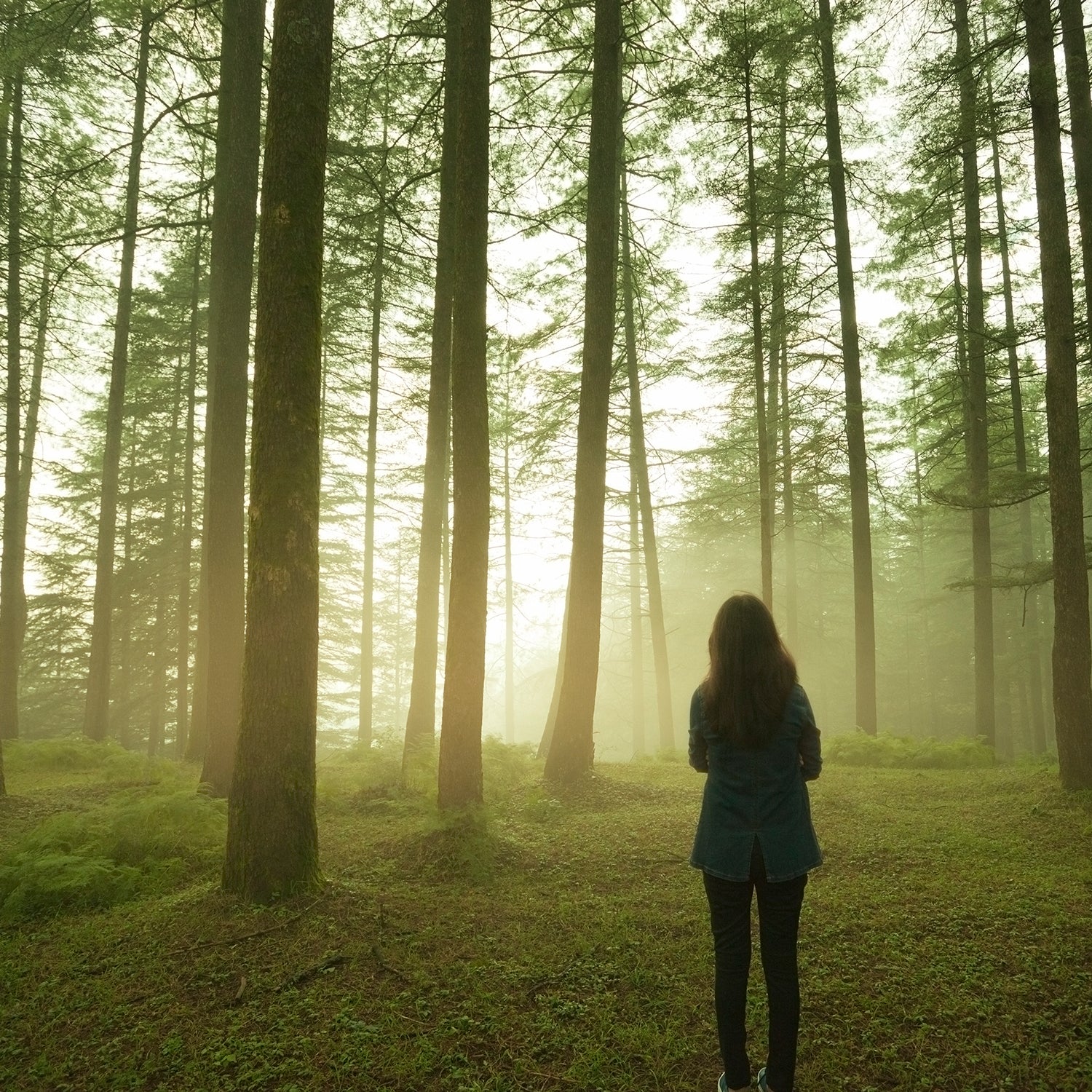Under a nimbus of eucalyptus and cypress boughs, in the pale waning light of a San Francisco afternoon, I watched the maraca of compulsory gratitude draw nearer. “Calm,” the peaceful-looking young blond woman said, then passed the shaker to her left. “Centered,” the young guy beside her said, then passed the shaker to his left. “Grounded,” a shorter but also peaceful-looking blond woman said. The maraca had almost reached me. “Creeping unease,” I thought.
An hour earlier, I’d felt only excitement, having finally made it to one of these forest bathing gatherings . The activity originated in Japan in the 1980s as shinrin-yoku, sometimes translated as nature bathing. The idea, more or less: Go be in nature, a little more deliberately than usual. Open your senses. Inhale some pine. Caress an acacia. Sound pleasant? Good, because it has caught on stateside.
You forest bathe for all the reasons you already know: our busyness, our email overload, our general disconnect from nature. A 2001 EPA-sponsored reported that Americans spend 87 percent of their time inside, plus another 6 percent in an enclosed vehicle. Whatever bureaucrat had to call a car an enclosed vehicle surely needs a forest bath as much as anyone.
Good news, EPA worker: Dedicated nature time doesn’t just feel good, it is good. Shinrin-yoku first took root after research showed it to have actual proven health benefits. found that forests “promote lower concentrations of cortisol, lower pulse rate, lower blood pressure, greater parasympathetic nerve activity, and lower sympathetic nerve activity than do city environments.” found significantly decreased levels of hostility and depression among subjects who spent a regular amount of time in forests.
One Meetup registration, an online questionnaire, and $30 later, I was officially ready to try this outdoors business.
The 30th gathering of the San Francisco–based occurred on a Sunday afternoon in the Presidio, the city’s gorgeous 1,500-acre military post turned national park. The group first convened in 2015 and has lately ramped up to four or five events each month. I arrived at the meeting spot to find two dozen mostly young professional-seeming people assembled. They’d found the club through Meetup and a group called Kismet, which offers “a series of high-vibe workshops for curious, creative, open-minded individuals.” Meanwhile, Julia Plevin, founder of the Forest Bathing Club, offered to glitter people’s faces. “Amazing,” one of the glittered women said. Other things I’d hear called amazing over the next two hours: the trees, a breeze, the view, a different set of trees.
Plevin is a wonderfully kind, perma-smiling woman who wears multiple necklaces and appealingly complex hippie moccasins. Her path to forestpreneur was the wandering sort: a weeklong training with the , some shamanic Reiki study, and time with a Maori forest guide in New Zealand, a Shugendo Buddhist monk in Japan, and Mayan elders in Guatemala. (“I’ve also logged hundreds of hours with my best teacher—the forest herself!” she told me.) In March, Ten Speed Press will publish Plevin’s first book, . Assisting Plevin was a young man named Sam—“chief boyfriend”—and he, too, was lovely. The bathers themselves, mostly newbies like me, were friendly and open to a one. And then we were off—into a series of brief exercises that left me relaxed and a little troubled.
Is nature becoming just another buzzworthy experience we pay to be curated?
We began in a broad clearing, with Plevin inviting us to form a circle and remove our shoes—bare feet reduce pain and inflammation, she told us.
“Bring your eyes to closed,” she said. I brought my eyes to closed.
Next, she asked us to turn, breathe in, and open our eyes. I did this, too. There were tall trees behind me, just as I’d suspected. We did some yogic movements, bending down, reaching for the ground, standing up, reaching for the sky. We sat and Plevin asked everyone to supply a word for how we were feeling.
“Jaguar is the day’s animal. It means fortitude,” Plevin told us as we moved on to the next activity. “Pick a partner. Discuss your need for fortitude.” A friendly woman and I meandered down a narrow trail and did as instructed. Then it was time to split up and spend time near a tree of our choosing. I found a wide redwood and pressed my hand into spongy bark. We’d been given a handful of corn kernels to ritually cast off when the moment felt right. It can be hard, knowing when to cast off one’s corn kernels, but I went for it, and we reconvened for more sharing. Calm, peace, gratitude.
So went the bath, a mix of established forest bathing techniques and Plevin’s personal interpretation. At one point, I bathed alongside a slender Monterey cypress, watching moody whitecaps form on the bay to my north. At another I searched for my “wak’a,” a totem of sorts that Plevin said would speak to us from the forest. (“Is that…Japanese?” I asked. “I think it’s from the Amazon,” she replied.) Time for more reflection. We were asked: What does nature give to us and what do we give to nature? Later, we all brought different objects—a leaf, a stick, a branch—to a clearing and, with much ceremony, placed them on a pile: an alter to our own appetite for solemn, culturally nebulous ritual.
Was any of this bad? Of course not. Nature and reflection are good! But something was eating at me—not the bathing itself so much as our need for it. What does it say when our species requires a spiritual docent for visits to the woods, when we must issue regular reports on how we’re feeling? We may have been offline, but the scent of social media hung in the air—the frequent status updates we were asked to supply, the Instagram-like amazingness of everything. Is nature becoming just another buzzworthy experience we pay to be curated?
It was dusk when we gathered in our last circle for some healthy snacks and tiny cups of cacao. Cacao “opens your heart,” Plevin informed us. We were pivoting back to real life. She invited us to take a pin, branded with the club’s name. If we wished, we could also apply to the club’s first-ever Nature Accelerator program: three days of intensive forest bathing for those keen to “discover the medicine you have to offer to this world.” (“We believe that people who are deeply attuned to the Earth make the greatest entrepreneurs,” the club’s website reads.) And that was a wrap. Before we left, we were given some small crystals and palo santo sticks, which presumably meant something interesting to whatever culture they’d been borrowed from.
Had shinrin-yoku improved my health? Who knows—I just felt like me, though maybe that itself is a small victory these days. In the weeks to come, I watched my inbox fill with notices from the Forest Bathing Club: ads for upcoming gatherings, a query on the state of my fire, links to articles I might like, lest I wished to spend more time at my computer but wasn’t sure how. Well, fine. As humanity flocks more and more to cities, I support anything that nudges us out of them periodically, and, hell, I support anything that reduces pain and inflammation.
But I also like plain old trees and bushes and dirt, the kind requiring no escort and promising no results. You just clomp around, and you sit on an uncomfortable rock, and a nuthatch pecks at some pine seeds, and that’s enough—off you go in your enclosed vehicle until next time.


